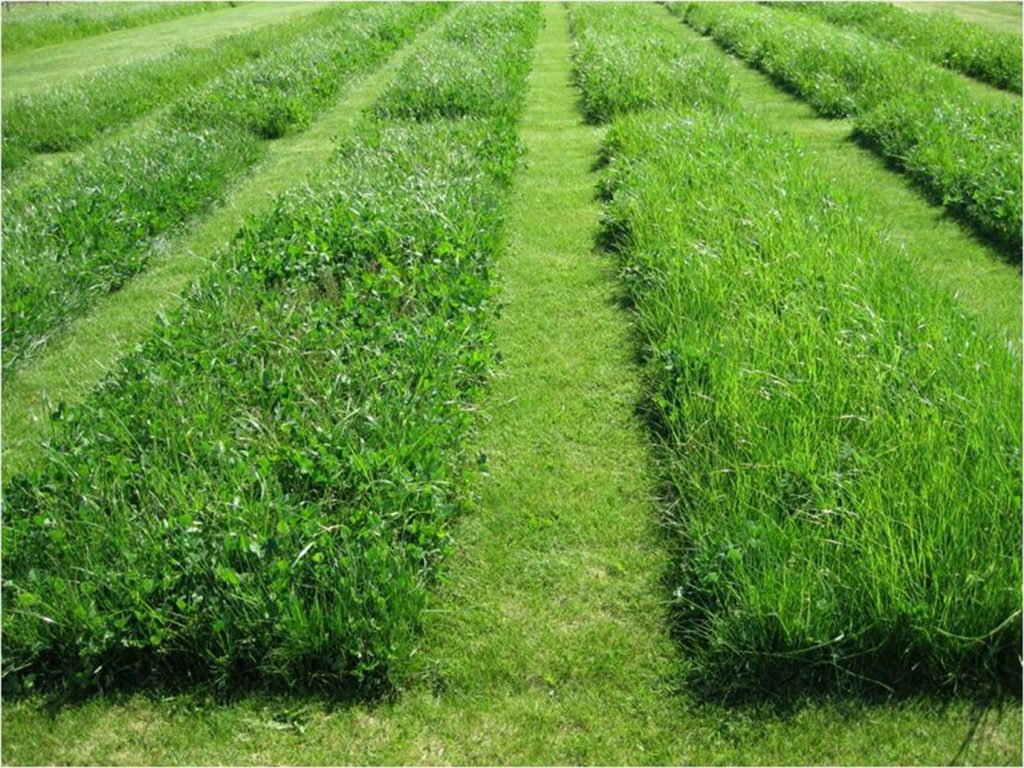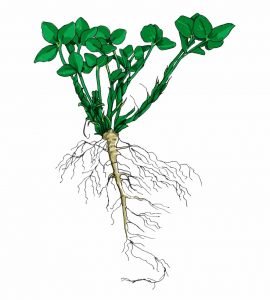With the help of this guide, you can figure out how to sow red clover seed and make the most of this legume in your pasture.
Understanding red clover
Red clover is a short-lived perennial herbage legume that typically persists for two-to-four years.
The plant
Red clover has an upright growth form and a strong deep taproot from which finer roots arise. The crown is located at the base of the stem and acts as a store of nutrients. Differences in the size and reserve status of the crown affect persistency and suitability for particular grassland management regimes.
Usage
Red clover can be most effectively grown in a grass/clover sward, but can also be grown as a monoculture to provide high yields of protein-rich forage.
The development of more grazing-tolerant and persistent varieties is creating the potential for red clover in rotational grazing systems. Red clover also has value as a break crop that improves soil structure and fertility.
Cutting and grazing heights
As the crown is above ground, damage must be avoided to ensure plant survival:
- In wet weather, avoid heavy machinery and pugging
- Cutting height for all silage cuts should be 7-8 cm minimum
- Optimum grazing height of aftermaths or over winter is 4-6 cm
Key benefits of red clover
Nitrogen fixation
Rhizobium bacteria exist symbiotically within red clover root nodules and produce available nitrogen.
High yields
Red clover swards can produce 10-15 tonnes DM/ha/yr.
Feed value
Protein content is particularly high in red clover, and there is a reduction in protein loss in the silo. Feed value is greater than it appears on analyses due to the composition of the protein, and exceptional finishing results can be achieved.
Break cropping
Red clover has significant benefits as a break crop in mixed farming situations because of its ability to improve soil structure and nutrient status.
Monoculture or companion grass
Red clover is primarily grown in a mixed sward but can also be grown as a monoculture. Aber High Sugar Grass perennial ryegrasses can make a great companion for a highly digestible and protein-rich feed source.
Advantages of growing red clover with a companion grass:
- Reduced impact of pugging
- Utilisation of fixed nitrogen by grass
- Improved nutritional balance
- Less leaching of nitrogen into the environment
Bloat awareness
Bloat is the excessive build-up of gas (carbon dioxide and methane) in the rumen and can even result in distress and possible death due to the exertion of pressure on the animal’s diaphragm, heart and lungs.
Oestrogenic content
Red clover typically contains high levels of phyto-oestrogens, particularly formononetin, which can cause a reduction in ovulation rates in ewes. Therefore, it is advisable to avoid grazing red clover varieties with ewes and rams from six weeks before to six weeks after tupping.
Red clover seed breeding objectives
The main objectives of IBERS’ red clover breeding programme are:
- Maximising yield
- Greater resistance of pests and diseases, particularly of crown rot and stem nematode
- Increasing persistency, maintaining yields into the fourth year and beyond
- Improving tolerance of grazing and trampling by selecting strong crowns to allow greater flexibility in use
- Extension of the growing season through earlier spring growth
- Improved winter survival of plants
- Improved nutritional quality to enhance protein utilisation and reduce nitrogenous losses
- Greater tolerance of environmental stresses, particularly drought
- Enhanced polyphenol oxidase levels to prevent rapid degradation of plant proteins and lipids in rumen and in silage
Disease resistance
IBERS has an ongoing screening programme for resistance to diseases such as Sclerotinia and stem eelworm in red clover. Several breeding lines with improved resistance have been identified and these, along with resistant wild ecotypes that have been collected from around Europe and Asia, are being used to develop new varieties of red clover.
Greater persistency
One of red clover’s shortcomings has been its relatively short persistence, typically remaining in the sward for just two to three years when a longer and more productive life would make it more compatible with medium-term grass swards.
The long term trial plots at IBERS are now showing the results of breeding for longer-lived red clover, with fourth-year data revealing new varieties that are still producing in the region of 14 tDM/ha. The new material is totalling around 60tDM/ha compared with 40-45tDM/ha from the controls.

Polyphenol oxidase (PPO)
Efforts are underway to increase the levels of polyphenol oxidase (PPO) in red clover. PPO is an enzyme that plays a role in the protection of protein and lipids from degradation in the rumen and under silage.
A proportion of the protein content of red clover is lost through oxidation under silage. This can be as high as 30% of the overall content, with the nitrogen content of the degraded protein being lost through leaching. Similarly, a large proportion of plant proteins are degraded in the rumen, which results in a loss before there is any potential for digestion by the grazing animal.
Fortunately, enhancing PPO levels can help the retention of protein through silage and digestion while maximising the nutritional qualities of the forage and preventing loss of nitrogen to the environment.
PPO can also protect plant membrane lipids during silage and in the rumen. This can also impact the fatty acid profile of milk by increasing polyunsaturated fatty acids and decreasing saturated fats in the milk of cattle fed that are on red clover.
Germinal can also provide guidance on the effective management of white clover.

